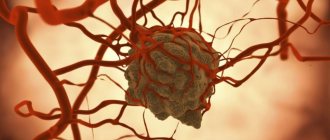When diagnosed with kidney cancer, metastases occur in 28% of patients. Moreover, even if tumor metastases of kidney cancer are eliminated at an early stage, after some time a recurrence of the disease or the growth of secondary formations in distant organs is possible. The average period of their occurrence after radical nephrectomy is 3 years, but there are cases where kidney cancer metastasizes to the lungs, discovered 15 years after the primary tumor.
The stage of the oncological process at the time of diagnosis also plays a role: after the diagnosis of kidney cancer metastases, the average life expectancy is no more than a year.
The main routes of spread are lympho- and hematogenous. In this case, the frequency of damage to distant organs is as follows:
• lymph nodes – 25-30%,
• liver and lungs – 50-60%,
• brain, bones – 30-40%.
There are 5 main types of cancer: papillary, clear cell, chromophobe, collecting duct, unclassified. Of these, kidney cancer metastasizes most often in the form of a clear cell type (up to 70-80% of cases), and least of all - the chromophobe type (only 3-5%). The neglect of cancer also affects the intensity of the spread of secondary formations: the likelihood of their appearance is much higher at stages III and IV. The second way kidney cancer metastases spread is through local penetration into neighboring tissues, for example, into the adrenal glands.
First, the tumor secretes special chemicals that stimulate the formation of new blood vessels and their growth into its stroma. Then some cancer cells enter the capillaries, as well as larger vessels, and, being picked up by the blood or lymph flow, are sent to peripherally distant tissues. Some of these cancer cells are destroyed by the immune system, but the survivors survive and give rise to new cancer foci. This is the way it spreads.
General symptoms
The appearance and development of malignant tumors can occur unnoticed, especially in the case of small sizes. There are several main symptoms:
• pain in the lower or lateral parts of the back not associated with injury;
• increased blood pressure;
• swelling of the legs, ankles;
• blood in the urine;
• bleeding may occur due to germination in blood vessels;
• intoxication with decay products of tumor tissue and sudden weight loss without obvious reasons often occur.
Visiting the Vivantes Clinic in Berlin
After treatment at home, pain in the neck was intermittent, mainly when swallowing, and practically did not appear during the use of a cervical orthosis.
However, taking pazopanib caused I. an unacceptable decrease in the number of leukocytes, and he had to stop it at the beginning of 2021. She contacted the Vivantes Spandau Clinic in Berlin, the head of the Center for Oncology and Hematology, Professor Ernst Spaeth-Schwalbe, to receive recommendations for further treatment. This choice was not accidental, because Professor Shpat-Schwalbe is a world-famous oncologist, a major specialist in the complex therapy of malignant tumors, including palliative therapy. And in this case, palliative therapy was required, since metastases in the spine distant from the primary site indicated stage IV cancer, when radical treatment is impossible.
Liver lesions
The liver has an intensive blood supply, so kidney cancer metastases often enter here through the bloodstream and settle here. Interestingly, of all malignant neoplasms found in the liver, secondary ones account for 90%. At first, when the resulting secondary tumors are small, there are no symptoms.
However, as the tumors grow, the following symptoms may appear:
• decreased or lack of appetite,
• increased weakness,
• fast fatiguability,
• fever,
• sudden weight loss,
• feeling of discomfort and pain in the right hypochondrium.
When the bile ducts are blocked by a tumor, obstructive jaundice develops - the urine becomes dark, the stool becomes light, and the skin and whites of the eyes acquire a yellow tint. Subsequently, the liver ceases to perform its functions, which ultimately can lead to ascites - the accumulation of fluid in the abdominal cavity.
Metastases
Kidney cancer primarily leads to metastases. Cells spread in two ways - through the lymph nodes and hematogenously (transmission through the blood through veins and arteries). The appearance of metastases in other organs is accompanied by obvious symptoms and pain. Signs of rapid progression of the disease cause more harm to the body than kidney cancer itself.
Tumors 2-3 cm in size are capable of metastasizing, but a progressive tumor begins to spread throughout the body in the form of metastases. In the history of Japanese medicine, a case is described in which a patient with an 8 mm tumor died 7 months after cancer diagnosis due to abundant metastases to vital organs.
Lungs
Symptoms are characterized by pain in the lungs with deep breaths, coughing up blood, sputum, and coughing fits. It is possible to detect metastases on CT and radiographs. There is a 30% chance that the organ will be the first to metastasize. Detection of kidney cancer makes it necessary to examine the lungs.
Bones
The spine and pelvic bones are affected. This is determined by aching, persistent pain in the bones, causeless bone fractures (caused by bone fragility), numbness of the limbs, urinary and fecal incontinence. The pain is not relieved by painkillers and is active at night.
Brain
The brain suffers. Brain metastases cause headaches that worsen when bending over or lying down. Signs include nausea, convulsions and, rarely, mental abnormalities. Metastases in the brain are more dangerous. A person loses the ability to think sensibly and be self-aware.
Lymph nodes
Lymph nodes accumulate cancer cells, and seals appear. Metastases rapidly spread throughout the lymphatic system. Swollen lymph nodes warn a person about the beginning of the process of destruction of the body.
Leather
Metastases that spread to the skin are rare, but any patient needs to familiarize themselves with the information. The lesions involve the skin, red swellings and dense nodes appear on the veins. The skin on the genitals, abdomen and head is more often exposed to metastases.
Diagnostics
In order to identify the disease, the doctor must prescribe a suitable research method. Among them:
1. Ultrasound diagnosis, which often includes a biopsy.
2. CT scan of the retroperitoneum - makes it possible to examine the kidney in detail.
3. Analysis for blood biochemistry and tumor markers.
4. Excretory urography - a procedure that includes radiography using contrast (it is injected into a vein before the procedure begins).
5. Renal angiography – makes it possible to assess the condition of blood vessels. A contrast agent is also used.
Ultrasound ablation
Treatment of kidney cancer with ultrasound ablation - the main thing is a directed ultrasound beam with a high level of energy. The use of the technique is not accompanied by violations of the integrity of skin tissue. This is the only method that destroys the tumor focus non-invasively. Many scientists consider it one of the most promising.
The technique is based on the ability of ultrasound waves to act on foreign cells without directly affecting other tissues of the body. In fact, the beam simply penetrates through other tissues, focusing only on the pathological one. The temperature in the local area increases significantly, which damages the tumor tissue. Once the procedure is complete, the cancer cells disappear and a scar or connective tissue appears in their place.
Embolization of arterial vessels
Insertion of a catheter into an artery located in the groin is used when it is impossible to carry out full operations, for example, in patients with severe cardiovascular diseases.
With the help of a catheter, the malignant tumor receives a special substance that disrupts its blood supply, which causes the death and destruction of tumor structures. When the patient's condition is stabilized, removal is performed - nephrectomy.
Treatment Options
Treatment is complicated by the fact that the patient comes to the doctor too late. Treatments are available that slow down cancer, even eliminating the disease in the fourth stage. Doctors use surgery, targeted therapy, immune therapy, and radiation therapy. Technologies in medicine are developing rapidly - new drugs and devices that can treat cancer appear every year. A cancer patient needs to study information on the topic separately. The difficulty is the price. Different methods require different costs.
Surgical methods
Surgery is rarely used - patients in advanced condition cannot withstand surgery. But the surgical method is the most effective. Usually single metastases in one organ are removed. For patients with metastases in two or three organs, surgery is not suitable. Surgical intervention improves prognosis by 25% in the first stages, in the third and fourth stages by 15%. Patients with distant metastases live longer after kidney cancer than people who have undergone targeted radiation therapy.
The patient undergoes a nephrectomy, i.e. The entire kidney is removed. A tumor up to 15 mm in size at the first stage requires resection. The operation allows you to save the kidney, improve the normal functioning of the organ and the health of the patient.
Radiation therapy
Tumors of all types are not sensitive to radiation, and doctors rarely recommend radiation treatment. The exception is the patient’s intolerance to targeted drugs. The insensitivity of kidney tumors to radiation is due to a protein in cancer cells that prevents rays from reaching the site. Radiation therapy blocks brain metastases, reducing pain. It is noted that the procedure improves the patient’s condition while maintaining metastases in the body. It is used in the final stages of cancer.
Immunotherapy
Taking medications helped 15% of patients. The ratio sounds disappointing. Immunotherapy treatment is prescribed for those who cannot undergo radiation therapy and surgery. Immunotherapy will help at the mild stage of cancer, the first stage, the beginning of the second stage. The technique began to be used in the 80s of the last century, and over the decades it has developed rapidly.
The development of immunotherapy does not stop now. A breakthrough was the invention of the drug Nivolumab in the USA - doctors around the world noted its advantages. The drug serves as an antibody in the human body and blocks the formation of cancer cells. Pharmacology is developing rapidly; old drugs are being replaced by new ones.
Targeted therapy
Treatment is aimed at combating tumor molecules. The cancer cell is attacked, tumor growth slows down. Rarely does targeted therapy manage to get rid of the disease completely. Treatment is prescribed for clear cell cancer. It is taken in the form of tablets, the daily dose, the time of use is calculated by the patient’s personal doctor.
The disadvantage of targeted drugs is side effects. The body weakens when fighting cancer, drugs have a stronger effect on a sick person and cause more side effects than in a healthy person. Manifestations are characterized by weakness, hypertension, itching, diarrhea, neutropenia (decreased neutrophil levels). But sometimes negative consequences are justified by the successful outcome of treatment.
The second disadvantage of targeted drugs is that the body gets used to them and begins to reject beneficial substances. Doctors fight rejection with complex drugs, trying by any means to deceive the body. Targeted drugs are prescribed before operations to check the body’s readiness for stress and prepare it. The patient's operation with targeted treatment is easier.
Chemoembolization
The latter method blocks the arteries feeding the tumor. Nutrients, minerals and blood stop flowing into the lesion. A catheter is connected to the artery near the tumor, microspheres with the diameter of the artery are introduced, and the passage of nutrients and blood is blocked. In parallel with the procedure, the human body is treated with other drugs that can improve the operation.
Chemoembolization is not only used for kidney cancer. The procedure is used to combat metastases in lung, pancreatic and breast cancer. Scientists continue research and are constantly finding new uses for chemoembolization for medical purposes.
Chemoembolization procedure
Chemotherapy
It has been scientifically proven that kidney cancer metastases to distant organs are practically insensitive to drugs used in chemotherapy to destroy cellular structures. But research into the development of effective chemotherapy drugs continues, and some of them are already being tested in clinical settings.
A number of drugs approved for chemotherapy slow the spread of malignancy, which makes it possible to increase the patient's life expectancy.
In such cases, attending physicians recommend more progressive LAK and TIL therapy.
Peculiarities of nutrition of patients
With stage 4 oncology, not only drug and surgical treatment are important. A person will have to significantly change their previous lifestyle and begin to adhere to certain doctor’s recommendations, in particular regarding nutrition. What should be the diet for stage 4 kidney cancer? Let's look at the basic tips:
- exclude smoked, salty and spicy foods from the diet. Do not drink carbonated drinks. Do not drink coffee or strong tea. Avoid sweets, legumes, canned food, and fatty broths;
- do not drink alcohol;
- limit consumption of lean meat and fish. Eat less butter. Minimize the amount of salt and spices in cooking;
- enrich the diet with cereals, dairy and fermented milk products;
- you can eat eggs - chicken and quail;
- saturate your diet with fruits and vegetables.
It is recommended to cook food by steaming or boiling. This is what nutrition should be like for stage 4 kidney cancer. Following these recommendations will help to significantly improve your well-being and general condition of the body. Also, proper and balanced nutrition in accordance with the doctor’s recommendations will improve the prognosis for stage 4 kidney cancer.






